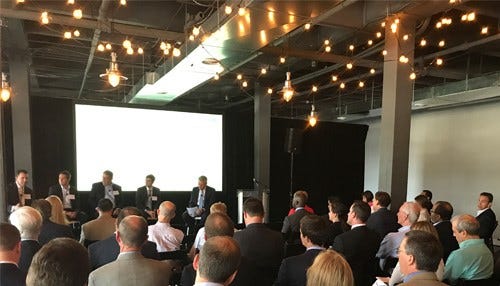Indiana Analyzes 15 Years of Capital, Sets Stage for Future
 A BioCrossroads Frameworx event placed Indiana’s life sciences capital market under the microscope.
A BioCrossroads Frameworx event placed Indiana’s life sciences capital market under the microscope.
Subscriber Benefit
As a subscriber you can listen to articles at work, in the car, or while you work out. Subscribe NowIndiana life sciences leaders believe a “proof of concept” is being delivered to the sector’s capital market. Determined to shed Indiana’s stigma as a venture capital “flyover state,” leaders of the earliest life sciences funds are trumpeting recent victories and—after spending years in the trenches—helping craft the strategy for Indiana’s future in life sciences funding.
As BioCrossroads was establishing its footing in 2003 as the state’s life sciences initiative, it also led the charge to form the Indiana Future Fund (IFF), a $73 million fund-of-funds for early-stage life sciences capital in Indiana. The investment paid off; early this year, Eli Lilly and Company acquired CoLucid, a late-stage startup developed through and thanks to a major investment by the venture capital firms participating in the IFF, for $960 million.
In 2009, BioCrossroads helped organize INext, billed as the next generation of funding to fuel young life sciences companies. Currently about halfway through the life of INext, BioCrossroads President and Chief Executive Officer David Johnson says the “phenomenally successful” fund is returning impressive amounts of capital to its investors.
“Fifteen years after starting all of this, we’re really beginning to see the fruit of it,” says Johnson. “It’s nice to finally be able to not just talk about that generally, but to have some very concrete examples. People who were involved in building [the funds] are showing what extraordinary opportunities there are to launch new companies in the life sciences in Indiana, be very successful, solve critical human health issues and make money in the process.”
A BioCrossroads Frameworx event this week placed Indiana’s life sciences capital market under the microscope. Among the event’s featured success stories was Indianapolis-based BioStorage Technologies.
The company is the brainchild of Covance alumnus Oscar Moralez, who worked to raise capital for his business idea in 2002, “which was pretty challenging.” In addition to an IFF investment, Carmel-based Spring Mill Venture Partners invested in BioStorage in 2006, and the company grew to boast annual revenues of about $40 million. BioStorage was acquired by Brooks Automation, Inc. in 2015 for about $127 million.
“What I’ve seen over the last eight years I’ve been doing this is a lot more structure, a lot more rigor and a lot more vetting and helping these companies,” says Moralez. “Hopefully, that translates into more successes and bigger successes in the future.”
Moralez is now founder and managing director of Indianapolis-based angel investment firm VisionTech Partners. He says, despite the amount or type of capital a startup is looking for, the landscape remains “very challenging.”
“Part of the issue we have here locally in Indiana is many companies that are seeking capital have to go outside of Indiana to find it,” says Moralez. “And that means, in some cases, that they completely uproot and move the headquarters, the people, the technologies—everything.”
Moralez believes there are two critical holes in Indiana’s funding landscape: seed money and later stage capital.
“The proof of concept, product development stuff—there’s a significant gap there, so companies can’t even get their product to some sort development or proof of concept in many cases. It’s very, very difficult,” says Moralez. “Once the angels make their investments or early-stage investors come in, it’s really difficult to see where that next round of funding, or more institutional funding, is going to come from. It’s almost nonexistent in the Midwest.”
Johnson, however, believes the challenge “is more people than money.” He notes, while Indiana’s capital success stories are the result of great science, strong teams have executed the building of complex biotech companies.
“[Indiana] has developed, over the past decade, five or six teams of people that can do that. We need 20,” says Johnson. “Other parts of the country have more. If we had more people, we could come together to do that, and this would skyrocket. The venture capital market will find those people and put money where they are. Where you live doesn’t matter, it’s who you have.”
Johnson believes the 15-year retrospective—both its successes and trials—provide valuable context as the sector strategizes how the next generation of life sciences capital in Indiana could continue “in even better form.”
“Given how capital intensive this sector is, for us to have a really impactful life sciences initiative, we have to have a capital strategy to keep it funded and keep it going,” says Johnson. “We’re pretty determined to keep right on doing that.”
Moralez says he’s optimistic about the capital market in Indiana’s life sciences sector.
Moralez says the amount of time and capital required in the life sciences sector—in any state—are “turnoffs” for investors.
Johnson says BioCrossroads struggles to get people to recognize Indiana as an entrepreneurial environment for the life sciences.
